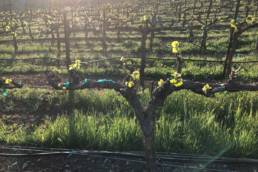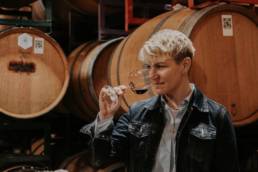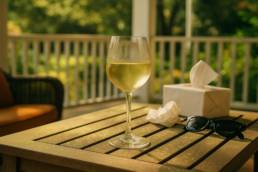FMN – August 2019 NY State Wines
When traveling, I always attempt to explore the native beverage scene. And by explore, I mean drink the wines made by the locals. This week I find myself in Upstate New York for a combination of business and pleasure. Although I cannot showcase all the impressive wineries and interesting varieties this area has to offer, I can introduce you to some greatly underappreciated wines.
New York has a long history of viticulture and wine making with Brotherhood Winery, founded in 1839, remaining the oldest continuously operating winery in the United States. At that time, many grape varieties were indigenous to the area and used for jams and jellies as well as grape growing (Ex: Concord, Niagra, Catawba).
In the late 1800s and early 1900s hybrids were attempted as a cure for the grape louse phylloxera. Although it proved unsuccessful in controlling this scourge, it provided new potential varieties that these marginal climate growers could adopt (Ex: Baco Noir, Chanbourcin, Vidal and Traminette). Cornell University, the enology and viticulture research and education center, continues to work with developing French-American hybrids that will tolerate the harsh environment, possess disease resistance and above all remain palatable.
Dr. Konstantin Frank, A Ukrainian immigrant, with a PhD in viticulture moved to New York in the early 1950s and began work at Cornell University’s Geneva Experiment Station. Within a decade, and against popular belief, he successfully grew vinifera vines in the upstate. His success changed not only the approach to viticulture in the Finger Lakes but elevated the popularity and validity of the region as a whole.
Growers working with fervor to experiment with consumer recognized varieties (vinifera) were given a further boost with the Farm Winery Act of 1976. This facilitated smaller family owned wineries to enter the industry by allowing them to sell a predetermined amount (50,000 gallons/year) of wine directly to the public. This created an exponential expansion in the numbers of wineries and even today new wineries continue to open.
New York boasts the third largest production behind California and Washington and the fourth most number of wineries by state. You would think that their wines would be on shelves everywhere, but quite the contrary. Outside the state of New York, and many times in state, consumers walk into the wine store and ask for wines from ‘west coast’ areas, Europe, or Oceania. I feel this has more to do with unfamiliarity of regions or grapes rather than quality.
In my native state of South Carolina, New York State wine sales are almost nonexistent. It’s difficult to sell wines where there is a lack of brand recognition, varietal recognition, and misdirected consumer perception of inferior quality. The discovery of quality and innovation can sometimes be found in the most unexpected places. If you the consumer are willing to explore these little-known regions, rewards will come in the way of a greater breadth of understanding and appreciation for wine as a whole. And by explore…well you know what I mean.
Suggested wines (uncertain availability):
Johnson Estate Feelings Creek Reserve Vidal Blanc Lake Erie, New York $11.99
Vidal Blanc is a hybrid created in France in the 1930s but was brought to eastern Canada in an attempt to jump start the brandy production. This crossing of Ugni Blanc (Trebbiano) and Rayon d’ Or was quickly repurposed for late harvest wines, including ice wines, due to its thick skins, disease resistance, tolerance to cold, and high natural acidity.
This example has an overt nose of melon (honeydew), honeysuckle, candied peach along with an orchard blossom. The palate is off dry but the perception of sweetness and overt acidity do a wonderful job of balancing each other to relative neutrality. The palate mimics the nose with unctuous melon, peach nectar and a lingering pleasant tropical citrus finish. Pair this wine with a pungent cheese (blue cheese tart or gorgonzola sauces), fruit salads, or cured meats.
Fulkerson Estate Gruner Veltliner 2016 Finger Lakes, New York $12.99
This wine does not resemble the spicy white pepper Gruner native to Austria but a great wine in its own right. The fragrant nose suggests tropical citrus (tangerine, pineapple), citrus blossom, peach skin, and spice (white pepper). The palate is dry with medium plus citric acidity and medium body. Flavors of citrus (lime, tangerine), orchard fruit (white peach) and a floral nuance emerge. Although a great ‘summer sipper’ it pairs well with ceviche, soft cheese and sunny days on a lake.
Dr. Konstantin Frank Rkatsiteli 2017 Finger Lakes, New York $16.99
The Rkatsiteli (kat-suh-tell-ee) grape is popular in the Eastern Europe especially the Republic of Georgia. In China called Baiyu, this ancient grape variety was rumored (with no definitive proof) to be the variety that Noah planted when the flood subsided.
The nose has tropical fruit (lime, pineapple), fennel and ripe orchard fruit. The dry palate (with a slightly off-dry perception due to ripeness of fruit) has bright, mouth-watering acidity, medium body, and a Riesling-like texture. This is an extremely interesting wine that finishes with a citrus blossom and baked apple skin nuance. Chill it down and pair with grilled sausages (knackwurst, bratwurst), pork with fruit sauces, or hot summer days.
Hosmer Cabernet Franc 2016 Cayuga Lake, Finger Lakes, New York $18.99
Cabernet Franc, one of the parents of Cabernet Sauvignon, is a red vinifera variety long associated with tolerating cooler climates throughout Europe. One first notices the interesting nose of spicy red fruit (raspberry) and woody herbs (thyme). The palate remains dry with bright tart fruit like acidity, medium body, integrated alcohol at 13.1% and a medium grained but integrated tannin structure. Flavors of black cherry, raspberry and a rapid acidic red fruit finish. Pair with grilled pork chops, chicken thighs or game birds.
Tug Hill Vineyards Marquette 2016 New York State $20.99
A cousin to Frontenac and a grandson to Pinot Noir, this French-American hybrid variety was developed at the University of Minnesota for its cold hardiness and disease resistance. This unique wine has a nose of crunchy red fruit (raspberry), black currant, black olive, peppercorn, and a rustic herbaceous note. The palate is dry, medium plus tart fruit type of acidity, medium minus body (think Pinot Noir type body), medium integrated tannins, and a tart red fruit and peppercorn finish. The wine has definitely benefitted from its aging in French oak. Pair this wine with duck, grilled chicken or lamb tagine.




